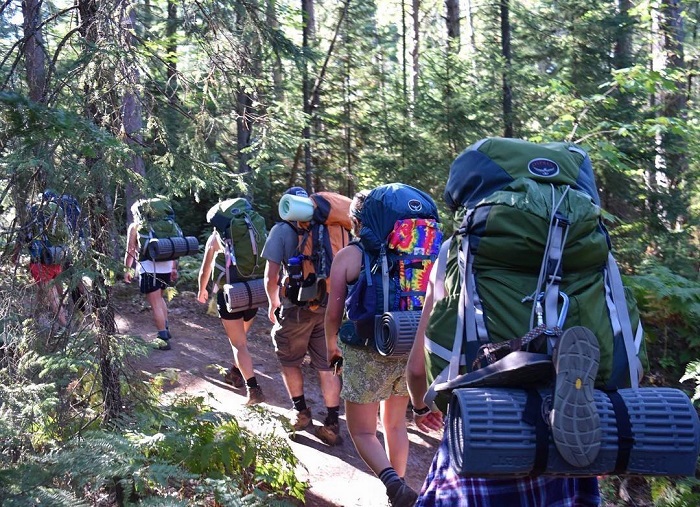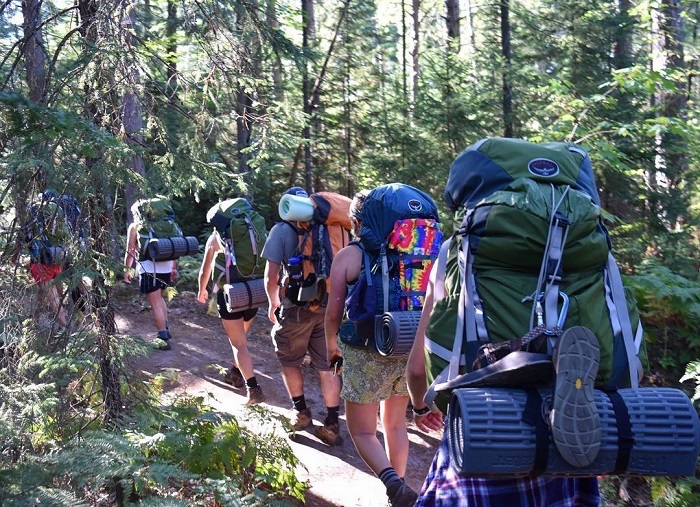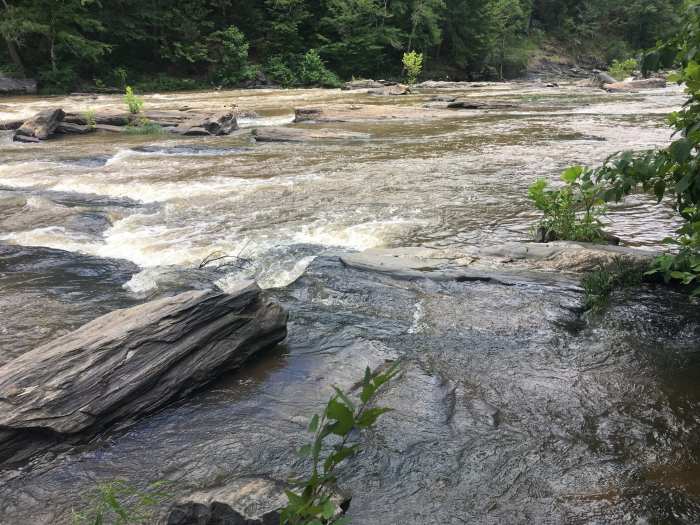Find a hiking trail near me is a crucial need for outdoor enthusiasts. This guide navigates the process of locating ideal trails based on your location, preferences, and available resources. We’ll explore various methods for specifying your search area, compare different trail databases, and discuss filtering and ranking options to help you find the perfect hike.
From precise addresses to broader regional searches, we’ll cover how to refine your location input. We’ll also highlight reliable sources like AllTrails and local park websites, outlining their strengths and weaknesses to make an informed decision. Finally, we’ll detail how results are displayed, including interactive maps, detailed descriptions, and user reviews. This comprehensive guide will empower you to embark on your next adventure with confidence.
Defining the Search Area
Locating hiking trails near a user’s position is a crucial component of any hiking trail discovery application. A precise search area is essential for providing relevant results and ensuring a positive user experience. Accurate location input and handling of various input types are critical for effective trail searches.Accurate location input is paramount to delivering a quality user experience.
The application must be able to process a range of location inputs, from precise addresses to broader regional searches. This requires a robust system for handling different input types and their associated potential ambiguities.
Location Input Methods
Different methods for specifying a user’s location enhance the search’s flexibility. Address information, including street addresses, city, state, and zip codes, allows for precise targeting. Alternatively, users can specify their location via city names or geographical coordinates (latitude and longitude). These various methods cater to diverse user preferences and input styles.
Handling Imprecise or Ambiguous Input
Location input may not always be precise. Users might enter slightly incorrect addresses or ambiguous city names. For example, a user might input “Los Angeles” without specifying the state, leading to ambiguity. The application needs to account for these imprecisions. Techniques like fuzzy matching or location-based refinement can resolve these uncertainties.
Fuzzy matching algorithms can find close matches to the provided input, while location-based refinement utilizes geographic data to narrow down potential search areas.
Handling Broader Regional Searches
Users may desire to explore hiking trails within a broader region rather than a precise location. The application should accommodate these broader searches by allowing users to input a radius or area of interest around a given point. For instance, a user might specify a city or landmark and request trails within a 50-mile radius. This feature enables exploration of a wider area and allows users to discover trails beyond their immediate vicinity.
Input Type Organization
Identifying Trail Databases

Source: ugbootsaleol.us
Locating suitable hiking trails necessitates access to reliable and comprehensive trail databases. These resources provide crucial information, empowering users to make informed decisions about their adventures. A variety of sources exist, each with its own strengths and weaknesses. Understanding these nuances allows users to leverage the most appropriate database for their needs.
Publicly Available Hiking Trail Databases
Numerous publicly accessible databases offer detailed information on hiking trails. These resources often include crucial data points, facilitating effective trail selection.
- AllTrails: A widely recognized platform, AllTrails boasts a vast collection of trails, globally. It gathers data from diverse sources, often supplemented by user-submitted reviews. The platform provides detailed information including trail names, distances, difficulty ratings, elevation profiles, and descriptions. However, its comprehensive nature sometimes means that locally specific trails might be less prominent.
- Local Parks Department Websites: For precise local trail information, local park websites are invaluable. These often have detailed maps, trail descriptions, and specific regulations. They are particularly strong in terms of up-to-date local data, offering current information on trail conditions and any closures.
- National Park Service Websites: For national park trails, the National Park Service (NPS) is the definitive source. This organization maintains detailed records of trails within its jurisdiction, including elevation profiles, historical information, and potential hazards. They often provide highly specific and detailed information, which is often essential for planning trips within national parks.
- Hiking Specific Websites: Several specialized hiking websites offer curated lists and detailed information about trails. These websites often feature trail reviews, photos, and even suggested itineraries, allowing users to gain an overall perspective on the trails and areas they are considering.
Types of Data Found in Trail Databases
Trail databases typically provide a wealth of information, enabling users to plan their hiking trips effectively. This detailed data ensures that users can select trails suitable for their abilities and preferences.
- Trail Name: Clearly identifying the trail is essential for navigation and planning.
- Distance: Understanding the length of the trail helps users gauge the time commitment required.
- Difficulty: Rating trails based on their difficulty (e.g., easy, moderate, difficult) ensures users select trails appropriate for their experience levels.
- Elevation Gain: Knowing the elevation gain and loss helps users assess the physical exertion involved.
- Amenities: Information on amenities like restrooms, water sources, or picnic areas is crucial for a comfortable and safe experience.
- Trailhead Information: Detailed trailhead information, including parking availability, directions, and potential hazards, is invaluable.
Comparison of Trail Databases
Different trail databases offer varying levels of detail and comprehensiveness. This difference necessitates careful selection based on the specific needs of the user.
Finding a hiking trail near you can be a rewarding experience, offering scenic views and physical activity. For a more tranquil experience, exploring creek trails near me can be a fantastic option. Check out creek trails near me for some great suggestions. These trails often provide a unique and refreshing alternative to traditional hiking trails, perfect for a pleasant day out.
Ultimately, finding the perfect hiking trail near you depends on personal preferences and the desired level of challenge.
| Database Name | Strengths | Weaknesses |
|---|---|---|
| AllTrails | Large database, user reviews, comprehensive global coverage. | May not be comprehensive for local trails; user reviews can be subjective. |
| Local Parks Department Websites | Comprehensive local information, up-to-date conditions, often specific trail regulations. | Limited coverage outside of local areas; information may not be as detailed as AllTrails. |
Filtering and Ranking Trails

Source: hikingink.com
Tailoring the search for the perfect hiking trail requires a nuanced approach. Users need a streamlined process for finding trails that match their specific preferences and experience levels. This involves not only identifying suitable trails but also presenting them in a way that’s easy to understand and compare. A well-designed filtering and ranking system is crucial for a positive user experience.Effective filtering and ranking mechanisms empower users to quickly pinpoint the ideal hiking experience, saving them time and effort in their search.
This efficiency translates to a more engaging and satisfying user journey, ultimately enhancing the overall platform’s value proposition.
Finding a hiking trail near you can be surprisingly simple. Leveraging online resources, like hiking trails in near me , provides comprehensive listings of local trails, enabling you to pinpoint the perfect spot for your next outdoor adventure. Ultimately, discovering a nearby hiking trail is just a click away.
Criteria for Filtering Trails
Users should have the flexibility to refine their searches based on a variety of criteria. This allows them to home in on trails that best align with their needs and desired experience. Clear and concise filtering options facilitate a focused search, minimizing the time spent sifting through irrelevant results.
- Distance: Users should be able to specify a desired distance range for their hike, whether they’re seeking a short, invigorating stroll or a more extended, challenging expedition. This allows users to tailor their search to their available time and energy levels.
- Difficulty: Trails vary considerably in difficulty, from easy, gentle paths to strenuous ascents and descents. Clear difficulty ratings, perhaps employing a standardized scale (e.g., beginner, intermediate, advanced), will help users select trails that match their skill level.
- Terrain: Terrain characteristics, including elevation gain, presence of water features, and types of surfaces (e.g., rocky, muddy, grassy), significantly influence the hiking experience. Users can filter by specific terrain preferences, ensuring a compatible match between their expectations and the trail’s characteristics.
- Amenities: The presence of amenities such as restrooms, water sources, or picnic areas can be a significant factor in choosing a trail. Offering filters based on the availability of these amenities allows users to choose trails that cater to their needs, especially for longer hikes or those with specific requirements.
Ranking Trails Based on User Preferences
Beyond simple filtering, ranking trails based on user preferences can enhance the user experience. Sophisticated algorithms can prioritize trails based on factors beyond the basic criteria, resulting in a more refined and effective search process.
- User Ratings: User-submitted ratings and reviews offer valuable insights into the hiking experience on various trails. These can be incorporated into a ranking system, allowing users to identify trails with positive user experiences. Trails with consistently high ratings can be prioritized.
- Popularity: Trails that are frequently visited or have high traffic can indicate a high degree of appeal to users. This metric can be considered in the ranking process to reflect popular options.
- Trail Features: The inclusion of features such as scenic overlooks, wildlife sightings, or historical significance can influence a trail’s appeal. Trails that offer unique experiences or specific features can be ranked higher based on the user’s preferences.
Methods for Presenting Results
The manner in which search results are presented significantly impacts the user experience. Clear and concise presentation facilitates efficient selection.
- Maps: Interactive maps offer a visual representation of trails, enabling users to see the route’s path and its relationship to surrounding features. This allows users to visualize the terrain and plan their journey effectively.
- Lists: Concise lists of trails with key information (distance, difficulty, amenities) can be presented for quick reference. This allows users to compare different trails side-by-side and make informed decisions.
- Summaries: Detailed summaries of each trail can provide users with a comprehensive overview of the trail’s characteristics, including user reviews and ratings, making it easy to understand the trail’s overall appeal.
Filter Options for Trail Searches
This table illustrates different filter options available for trail searches. This allows for a quick and easy understanding of the parameters involved in the search.
Displaying Results
Presenting search results for hiking trails requires a user-centric approach, prioritizing clarity and ease of navigation. A well-designed interface allows users to quickly identify trails that match their preferences, enhancing the overall user experience.A robust search engine for hiking trails needs a sophisticated structure to display results effectively. This structure must balance the need to present comprehensive information with a streamlined visual experience.
The layout should be intuitively organized, enabling users to quickly compare different trails and make informed decisions.
Result Presentation Structure
A well-structured display should combine a list format with a map view. This dual approach provides users with a multifaceted understanding of the search results. The list format allows for a tabular overview of key trail attributes, while the map view gives a spatial context to the trails’ location.
List Format
The list format offers a tabular view, presenting trails in a concise and organized manner. This tabular presentation clearly highlights key attributes such as trail name, distance, difficulty level, and nearby amenities.
| Trail Name | Distance | Difficulty | Amenities |
|---|---|---|---|
| Doe Trail | 3 miles | Easy | Picnic Area |
| Smith Trail | 5 miles | Moderate | Water Fountain, Restrooms |
| Jones Trail | 7 miles | Hard | Parking, Viewpoint |
This table-based structure is highly effective in displaying multiple trails simultaneously. It allows for rapid comparison across various trails.
Map Display
A map view provides a visual representation of trail locations. Users can quickly see the proximity of trails to their current location or a desired point of interest. Markers on the map can represent each trail, allowing for easy identification and selection. The map can also highlight nearby amenities, such as parking areas, restrooms, or restaurants. A clear legend and intuitive zoom/pan functionality are crucial to the effectiveness of the map display.
Detailed Trail Descriptions
Detailed trail descriptions are crucial for users to gain a comprehensive understanding of the trail. Descriptions should include information on elevation changes, trail surface, potential hazards, and notable landmarks along the route. Detailed descriptions enhance user engagement and provide vital information for a safe and enjoyable hike. Integrating user reviews and ratings can also enhance the trustworthiness of the information provided.
Presentation of Trail Details
Presenting trail details in a user-friendly format is paramount. Clear, concise descriptions of trail difficulty levels, user reviews, and proximity to nearby amenities enhance the search experience. The inclusion of star ratings for difficulty and user reviews provides users with a sense of the trail’s characteristics from other hikers’ experiences. Visual cues, such as icons or color-coding, can be used to quickly communicate trail difficulty, amenities, and other important information.
Visually Appealing and Easy-to-Understand Output
A visually appealing design is key to enhancing the user experience. Clear typography, well-organized layout, and intuitive navigation elements contribute to a seamless experience. Use of high-quality images and a consistent color palette create a professional and visually engaging platform. A well-designed user interface makes it easy for users to find and select the perfect trail.
Locating a nearby hiking trail is straightforward with various online tools. Understanding the nuances of hiking, like the different types of terrain and levels of difficulty, is crucial before you embark on your journey. For a comprehensive definition of hiking, consult this resource: Hiking Definition. Once you grasp the concept, exploring the numerous options for hiking trails near you becomes more rewarding.
Handling User Feedback and Updates

Source: michigan.org
Ensuring the accuracy and timeliness of hiking trail data is crucial for user safety and satisfaction. Inaccurate or outdated information can lead to frustrating experiences, potential hazards, and diminished trust in the platform. A robust system for handling user feedback and updates is essential for maintaining the reliability and value of the service.User feedback, ranging from simple comments to detailed reports, provides invaluable insights into the quality and utility of the trail data.
Integrating this feedback into the system is paramount for continuous improvement and user satisfaction.
Incorporating User Comments and Ratings
User comments and ratings offer direct feedback on trail conditions, difficulty, and overall experience. These inputs can be categorized and analyzed to identify recurring issues or areas needing attention. For instance, consistently negative comments regarding a specific trail’s steep incline might suggest the need for additional signage or alternative access points. Similarly, high ratings for a particular trail’s scenic beauty can reinforce the platform’s value proposition.
Finding a hiking trail near you is easier than ever with numerous online resources. To ensure you’re well-prepared for your outing, comprehensive information on hike details like elevation gain, trail difficulty, and estimated time is crucial. This vital information will help you pick the right trail for your skill level and experience. For detailed insights, consult resources like information on hike before embarking on your next adventure.
Ultimately, knowing the specifics of your chosen trail will lead to a safer and more enjoyable hiking experience.
Updating Trail Information Based on Feedback
Regular updates to trail information are vital for maintaining accuracy. This involves promptly addressing issues reported by users, updating details such as trail closures, recent maintenance, or changes in difficulty. A well-defined process should be in place to verify and validate user reports before implementing changes. This process should involve a review of the reported information, confirmation with external sources (e.g., local park authorities), and, if necessary, a field verification.
Feedback Mechanisms for Trail Data, Find a hiking trail near me
Implementing various feedback mechanisms allows for diverse user input. These mechanisms can include star-rating systems for trails, a comments section on each trail description, and a dedicated form for reporting issues. The platform could also allow users to upload images or videos documenting problems, such as fallen trees or eroded sections of the trail. This visual data can be highly valuable in verifying reports and assisting in updates.
For instance, a user might report a flooded section of a trail, providing a photograph as supporting evidence.
Ensuring Accuracy and Reliability of Trail Data
Ensuring the accuracy and reliability of trail data hinges on establishing a clear verification process. This process should involve cross-referencing user feedback with official trail information from local authorities, and incorporating feedback from experienced hikers. The system should also allow for a hierarchical review, where reports are assessed by moderators and potentially verified by experts or park rangers.
Handling User Reports of Incorrect or Outdated Information
A standardized procedure for handling user reports of inaccurate or outdated information is essential. This procedure should include a clear description of the process for reporting issues, a timeline for reviewing reports, and a notification system for users about the status of their reports. For example, a user reports a missing trail marker. The system should automatically flag this report, assign it to a moderator for review, and update the user with the status of the report (e.g., pending review, verified, or rejected).
This transparent approach builds trust and fosters a sense of community amongst users.
Last Word
Finding the perfect hiking trail near you is now easier than ever. By carefully defining your search area, leveraging robust trail databases, and utilizing advanced filtering techniques, you can effortlessly discover scenic routes that cater to your specific preferences. This guide provides a structured approach, enabling a seamless experience in your quest for outdoor exploration. We encourage you to leverage user feedback and contribute to the accuracy of the trail information.
Happy trails!
FAQ Overview: Find A Hiking Trail Near Me
What if I don’t know the exact address of the trailhead?
No problem! You can use a city, zip code, or even coordinates to specify your search area. The system will adjust accordingly, finding trails in the surrounding region.
How can I ensure the accuracy of the trail information?
User feedback plays a vital role. We actively incorporate user comments and ratings to maintain the accuracy and reliability of the data. If you encounter any inaccuracies, please report them through the provided feedback mechanisms.
Are there any trail databases besides AllTrails?
Absolutely. Local parks and recreation departments often maintain their own comprehensive trail databases, offering detailed information about local trails. We’ll compare and contrast various sources to provide you with a complete picture.
How can I filter my search based on difficulty?
You can easily filter trails by difficulty (e.g., easy, moderate, challenging). The system will present a list of trails that align with your chosen difficulty level.






Leave a Reply